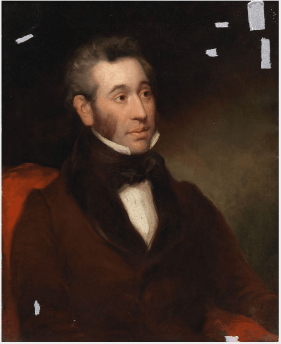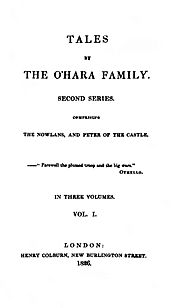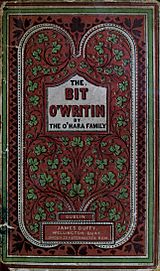John Banim facts for kids
Quick facts for kids
John Banim
|
|
|---|---|
 |
|
| Born | 3 April 1798 Kilkenny, Ireland |
| Died | 30 August 1842 (aged 44) Windgap Cottage, Kilkenny, Ireland |
| Pen name | Barnes O'Hara |
| Occupation | Writer |
| Language | English |
| Nationality | Irish |
| Period | 1821–1830s |
| Genre | Fiction, drama, essays |
| Subject | Irish history, Irish life, social issues |
| Literary movement | Romanticism |
| Relatives | Michael Banim (Abel O'Hara) |
| Signature | |
John Banim (born April 3, 1798 – died August 30, 1842) was a famous Irish writer. He wrote many different kinds of stories, including novels, short stories, plays, and poems. People sometimes called him the "Scott of Ireland" because he was so good at writing about Irish life and history, much like Sir Walter Scott wrote about Scotland. Before becoming a full-time writer, John Banim also studied art and worked as a painter and drawing teacher.
Contents
John Banim's Early Life and Education
John Banim was born in Kilkenny, Ireland. His father was a farmer and also ran a shop. When he was just four years old, John started learning to read and write at a local school. A year later, he joined his older brother Michael at the English Academy in Kilkenny. This school is even mentioned in Michael Banim's novel, Father Connell.
After five years, John went to a special school called a seminary, which was considered one of the best Catholic schools in Ireland. He later moved to another academy. Throughout his school years, John loved to read and write his own stories and poems. He had a unique birthday tradition: he would reread all his writings from the past year and then burn the ones he didn't like!
When he was ten, John Banim met the famous poet Thomas Moore. John even brought some of his own poems to show him. Moore encouraged John to keep writing and gave him a special ticket to his private theater.
At age 13, John went to Kilkenny College. Here, he spent a lot of time on drawing and painting tiny pictures called miniatures. He continued his art studies for two more years in Dublin and then taught drawing in Kilkenny. Sadly, when he was 18, a girl he cared about passed away from an illness. This deeply affected John, and he also became ill with a condition affecting his spine.
John Banim's Writing Career
Starting Out in Dublin
After recovering from his illness, John Banim started painting portraits and writing stories for a local newspaper, the Leinster Gazette. He soon became the editor of this paper.
In 1820, John decided to focus on writing and moved to Dublin. There, he reconnected with an old friend, the artist Thomas J. Mulvaney. John used his writing skills to help Dublin artists get a special permission, called a charter, and money from the government. Because of his help, the artists succeeded and thanked John with a good amount of money. He used this money to pay off his debts.
John also became friends with the writer Charles Phillips, who helped him with his writing. Phillips encouraged John to stay in Dublin and helped him get his early poem, Ossian's Paradise, published in 1821. It was renamed The Celt's Paradise.
Even before it was published, the famous writer Sir Walter Scott enjoyed reading John's poem. After The Celt's Paradise came out, John started writing a serious play. His play, Damon and Pythias, was performed in London in 1821 and later in Dublin.
In 1821, John visited Kilkenny to settle his remaining debts. During this trip, he talked with his brother Michael about their plans for writing novels and stories. He also met Ellen Ruth, and they fell in love. They got married in 1822.
John and Michael Banim then planned a series of stories about Irish life. They wanted these stories to be as important for Ireland as the Waverley Novels were for Scotland. They were also inspired by the everyday tales written by John Galt.
Writing in London
John and Ellen moved to London, where John supported them by writing for magazines and plays. His wife became ill, and John had to work even harder to pay for her treatment. In 1823, John's own illness returned, causing him financial difficulties.
Because of his health, he started writing more for monthly magazines instead of weekly papers. This allowed him to write more carefully and seriously. He also wrote stories for the English Opera House. Around this time, he met the young writer Gerald Griffin, who had just arrived in London. John became Griffin's friend and helped him with his plays. Griffin later wrote that John Banim was "the only man I have met since I left Ireland."
In 1824, John Banim published a book of essays called Revelations of the Dead Alive. He also met the American author Washington Irving that year. The first book in their series, Tales of the O'Hara Family, came out in April 1825 and was an instant hit. One of the most powerful stories in it, Crohoore of the Bill Hook, was written by Michael Banim. The brothers worked on these stories by sending their writings back and forth to each other. Gerald Griffin also helped by giving them feedback.
After the first Tales of the O'Hara Family, John started writing his novel The Boyne Water. This story was about the relationships between Protestants and Catholics during the Williamite War. He traveled to Ireland to do research for the novel, which was published in 1826. That same year, a second series of Tales of the O'Hara Family was published, which included the novel The Nowlans.
When Michael visited John in London in 1826, he noticed that John's illness had made him look much older than his 28 years. The next book from the "O'Hara family," The Croppy, a Tale of 1798 (1828), was mostly written by Michael. This novel was about the Irish Rebellion of 1798. Other popular books followed, including The Mayor of Windgap and The Ghost Hunter (both by Michael), The Denounced (1830), and The Smuggler (1831). Most of these stories explored the tougher parts of life, but his last work, Father Connell, was much brighter and more gentle.
In 1827, John became friends with another young writer, John Sterling. John's health improved for a short time after a trip with Sterling. However, his illness soon returned, bringing financial problems. He kept writing and encouraged Michael with The Croppy. In July 1827, John's daughter was born. In 1828, his novel The Anglo-Irish of the Nineteenth Century was published, but it wasn't very popular.
John and Gerald Griffin became close friends again in 1828. Their friendship was very important to both writers. During this time, John and his wife lived in different places in England, including Eastbourne and Sevenoaks, for John's health. In 1829, they moved to Blackheath, London for business reasons.
In late 1829, John went to France because his doctors recommended it. While there, he wrote The Smuggler, which wasn't published until 1831 due to a problem with the publisher. He also wrote another novel, The Dwarf Bride, but the publisher lost the manuscript. In June 1830, his mother passed away. John was too unwell to return to Kilkenny to see her. His family moved to Boulogne and then to Paris for medical advice. He continued to earn a living by writing for magazines and plays. In 1831, his first son was born. This brought joy after his mother's death, but also more financial needs. In 1832, he survived a serious illness called cholera.
At the end of 1832, his second son was born. Soon after, in January 1833, John's literary friends and the English newspapers, led by John Sterling, started a campaign to help him financially. Money was also collected in Ireland. Enough was raised to help him avoid serious financial hardship. Famous people like Charles Grey, 2nd Earl Grey and Sir Robert Peel contributed.
John Banim's Later Life
In 1833, John and his wife moved to Paris, hoping to find a doctor who could help his condition. He was diagnosed with inflammation of his lower spine and underwent painful treatments that didn't help. Sadly, his youngest son died in early 1834. He stayed in Paris throughout 1834, writing when he could and spending time with famous writers in the city. His oldest son died at the beginning of 1835 from an illness called croup.
While in France, John Banim had a stroke. In 1835, he slowly made his way back to Kilkenny. He returned to Ireland in July 1835 and lived in Dublin for a short time. When his brother Michael saw him in August, John was very ill and often in pain, needing medicine to sleep. However, during his good moments, he enjoyed talking with his brother and friends. In September, he returned to Kilkenny. The people of Kilkenny showed their appreciation for him and raised money to help him. After a short stay at his childhood home, he moved to Windgap Cottage, near Kilkenny. He spent the rest of his life there, passing away on August 13, 1842, at the age of forty-four.
John Banim's Legacy as a Writer
John Banim was especially good at showing the lives of everyday Irish people. He captured their strong feelings and the good and bad things that influenced them. He had a remarkable talent for this.
The Encyclopædia Britannica (a famous encyclopedia) wrote in 1911 that the O'Hara Tales are John Banim's most important works. They said these stories are "masterpieces of faithful delineation," meaning they truly and accurately showed Irish peasant life. The stories often had exciting, sometimes even shocking, events. While some thought he tried too hard for dramatic effects, his ability to show the deep feelings and struggles of Irish people was highly praised.
Works by John Banim
- John and Michael Banim bibliography
See also
- Fetch (folklore)
- Knights of Pythias




